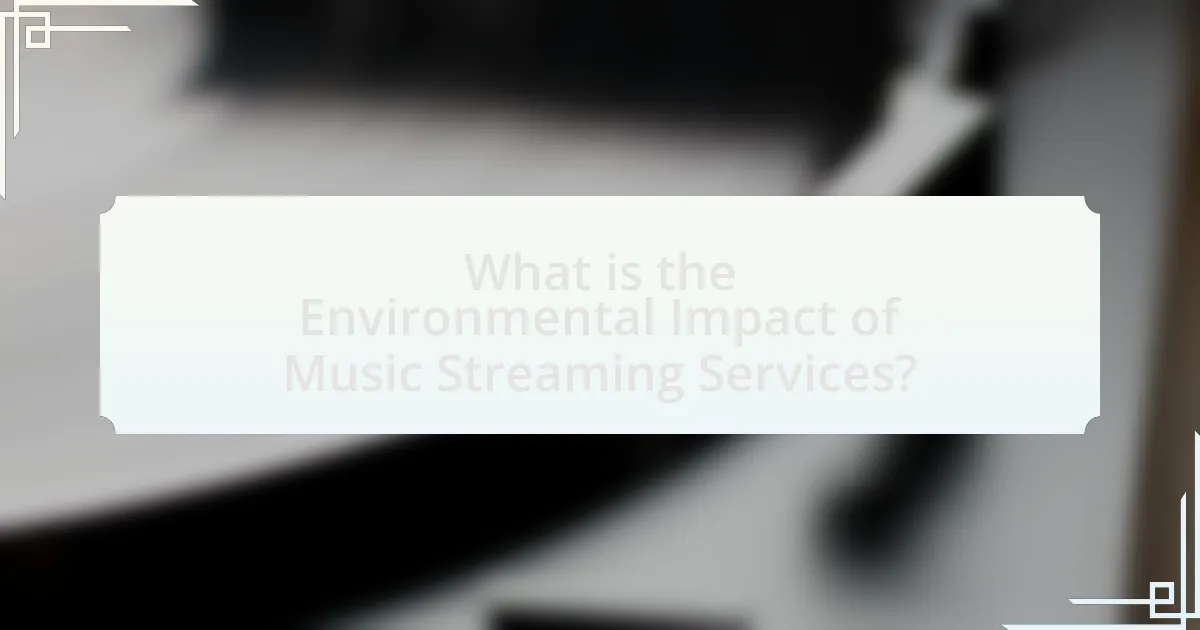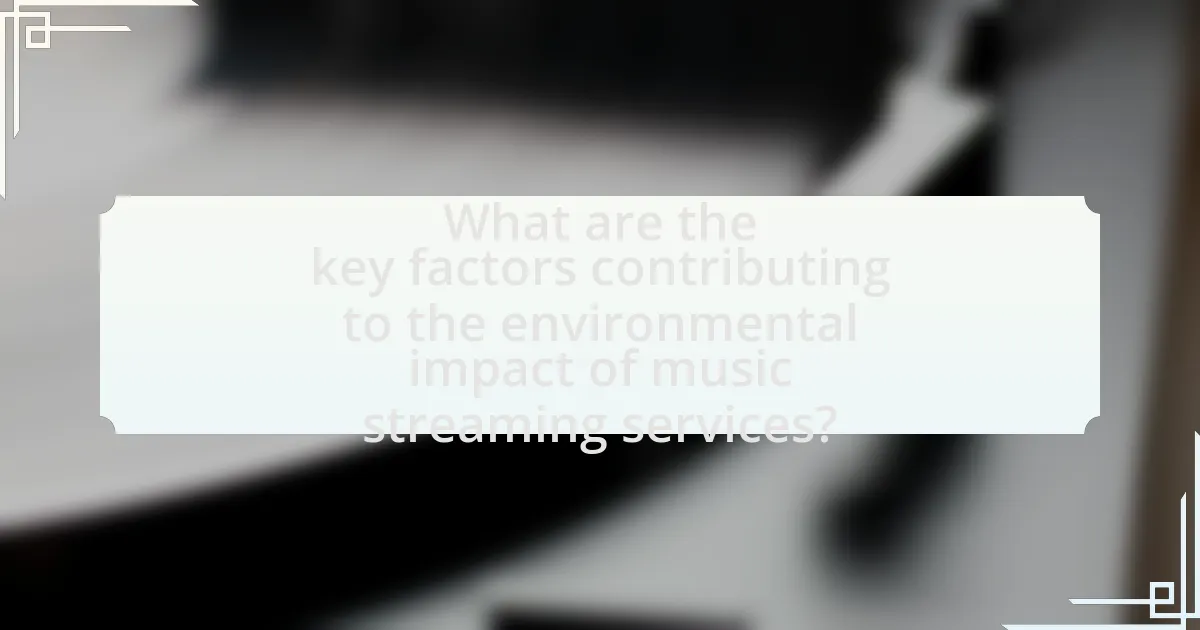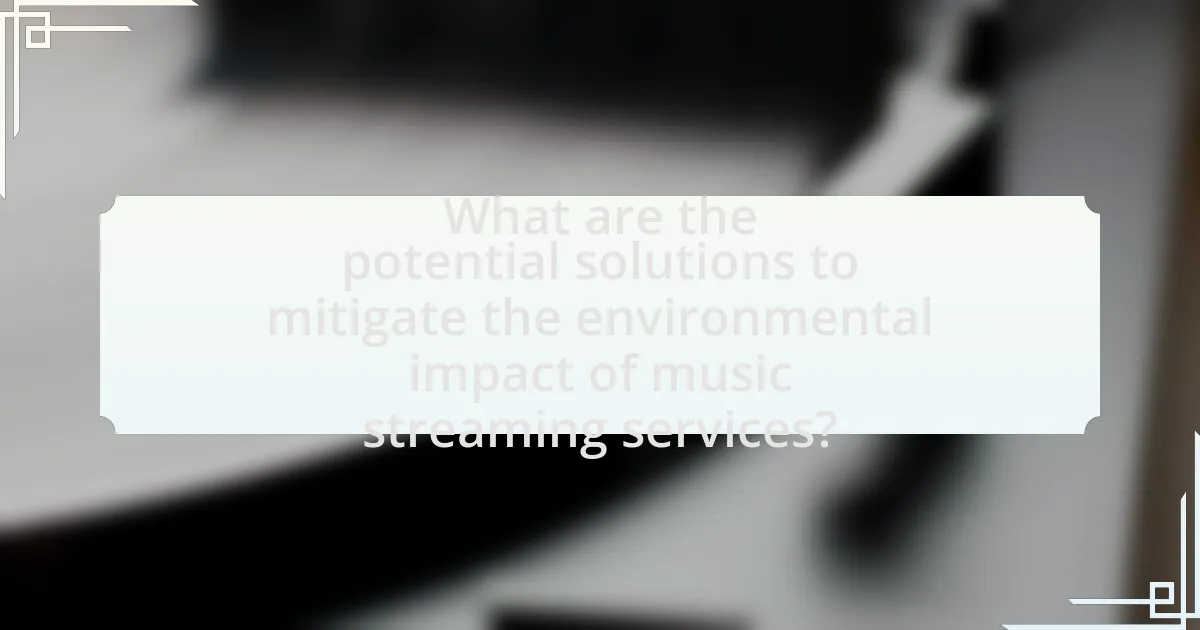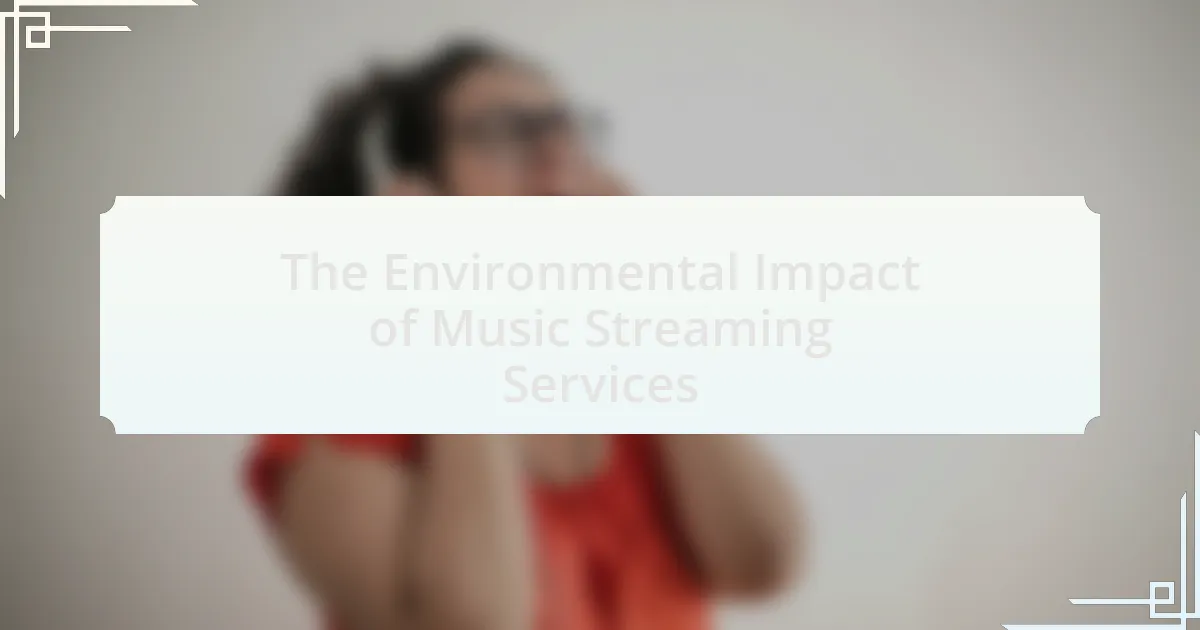The article examines the environmental impact of music streaming services, highlighting their significant energy consumption and carbon emissions due to reliance on data centers and network infrastructure. It discusses how streaming contributes to global electricity demand, with data centers accounting for about 1% of this demand, and estimates that music streaming generates approximately 200 million tons of carbon emissions annually. Key factors influencing this impact include energy sources, server efficiency, and user behavior, with recommendations for adopting renewable energy and optimizing streaming practices to mitigate environmental effects. The article emphasizes the importance of understanding these impacts for promoting sustainability within the music streaming industry.

What is the Environmental Impact of Music Streaming Services?
The environmental impact of music streaming services is significant due to their reliance on data centers and energy consumption. Streaming music requires substantial server infrastructure, which contributes to carbon emissions; for instance, a 2020 study by the International Energy Agency reported that data centers accounted for about 1% of global electricity demand. Additionally, the energy used for streaming can lead to increased greenhouse gas emissions, particularly if the electricity is sourced from fossil fuels. Therefore, while music streaming offers convenience, it also poses environmental challenges that need to be addressed through sustainable practices and renewable energy sources.
How do music streaming services contribute to environmental issues?
Music streaming services contribute to environmental issues primarily through their significant energy consumption and carbon emissions associated with data centers and network infrastructure. These services rely on vast server farms that require substantial electricity to operate and cool, leading to increased greenhouse gas emissions. For instance, a report by the International Energy Agency indicated that data centers accounted for about 1% of global electricity demand in 2020, a figure that is expected to rise as streaming becomes more prevalent. Additionally, the carbon footprint of streaming music can be substantial; a study published in the journal “Nature Communications” found that streaming one hour of music can produce approximately 0.2 kg of CO2 emissions, depending on the efficiency of the data centers and the energy sources used. Thus, the operational demands of music streaming services directly impact environmental sustainability through energy use and associated emissions.
What are the carbon emissions associated with music streaming?
Music streaming generates approximately 200 million tons of carbon emissions annually. This figure arises from the energy consumption of data centers, network infrastructure, and end-user devices involved in streaming services. For instance, a study by the Shift Project in 2019 highlighted that streaming a single hour of music can produce around 0.2 kilograms of CO2, primarily due to the electricity required for data transmission and storage. This energy often comes from fossil fuels, contributing significantly to the overall carbon footprint of digital music consumption.
How does data storage impact energy consumption?
Data storage significantly impacts energy consumption due to the power required to maintain and operate data centers. Data centers, which store vast amounts of information, consume approximately 1-2% of global electricity, according to the International Energy Agency. The energy consumption arises from both the servers that process data and the cooling systems necessary to prevent overheating. As the demand for data storage increases, particularly with the rise of music streaming services, the energy footprint of these operations grows, leading to higher carbon emissions if the energy is sourced from fossil fuels.
Why is it important to analyze the environmental impact of music streaming?
Analyzing the environmental impact of music streaming is important because it reveals the significant carbon footprint associated with digital music consumption. Streaming services rely on data centers, which consume vast amounts of electricity, often generated from fossil fuels, contributing to greenhouse gas emissions. For instance, a study by the Shift Project in 2019 estimated that streaming music generates approximately 200 million tons of CO2 annually, comparable to the emissions of a country like Portugal. Understanding this impact allows consumers and companies to make informed decisions about sustainability and encourages the adoption of greener technologies in the industry.
What are the long-term effects of streaming on the environment?
The long-term effects of streaming on the environment include increased energy consumption and carbon emissions due to data centers and network infrastructure. Streaming services require substantial electricity to operate servers and transmit data, contributing to greenhouse gas emissions. For instance, a study by the Shift Project found that digital technologies, including streaming, accounted for 4% of global greenhouse gas emissions in 2019, a figure projected to rise as streaming becomes more prevalent. Additionally, the demand for high-definition content further exacerbates energy use, as higher quality streams require more data transfer and processing power.
How does consumer behavior influence environmental outcomes?
Consumer behavior significantly influences environmental outcomes by determining the demand for products and services that either harm or benefit the environment. For instance, when consumers prioritize sustainable products, companies are incentivized to adopt eco-friendly practices, leading to reduced carbon footprints and waste. A study by the Nielsen Global Sustainability Report found that 66% of consumers are willing to pay more for sustainable brands, demonstrating that consumer preferences can drive market shifts towards environmentally responsible options. This shift can result in lower greenhouse gas emissions and less resource depletion, ultimately contributing to positive environmental outcomes.

What are the key factors contributing to the environmental impact of music streaming services?
The key factors contributing to the environmental impact of music streaming services include data center energy consumption, network infrastructure, and user device energy use. Data centers, which host the servers for streaming services, consume significant amounts of electricity; for instance, a 2020 study estimated that data centers accounted for about 1% of global electricity use. Additionally, the network infrastructure required to transmit data to users, including routers and cellular towers, also contributes to energy consumption. Furthermore, the energy used by individual devices, such as smartphones and computers, adds to the overall environmental footprint. Collectively, these factors highlight the substantial energy demands associated with music streaming, leading to increased carbon emissions if the energy sources are not renewable.
How does server infrastructure affect energy usage?
Server infrastructure significantly affects energy usage by determining the efficiency and performance of data centers. Efficient server designs, such as those utilizing virtualization and energy-efficient hardware, can reduce energy consumption by up to 80% compared to traditional setups. For instance, according to the U.S. Department of Energy, data centers consumed about 70 billion kilowatt-hours in 2014, highlighting the substantial energy footprint of server infrastructure. Additionally, the implementation of advanced cooling technologies and renewable energy sources can further minimize energy usage, making server infrastructure a critical factor in the overall energy efficiency of music streaming services.
What types of energy sources are used by data centers?
Data centers primarily use electricity as their energy source, which can be derived from various sources including fossil fuels, nuclear power, and renewable energy. According to the International Energy Agency, as of 2020, approximately 40% of global electricity generation came from renewable sources, such as wind, solar, and hydroelectric power, which are increasingly being adopted by data centers to reduce their carbon footprint. Additionally, many data centers are transitioning to green energy contracts to enhance sustainability and minimize environmental impact.
How does the geographical location of servers influence their carbon footprint?
The geographical location of servers significantly influences their carbon footprint due to variations in energy sources and climate conditions. Servers located in regions that rely on fossil fuels for electricity generation contribute higher carbon emissions compared to those in areas utilizing renewable energy sources like wind, solar, or hydroelectric power. For instance, data from the International Energy Agency indicates that countries like Denmark, which have a high percentage of renewable energy, exhibit lower carbon footprints for data centers compared to those in coal-dependent regions such as Poland. Additionally, cooler climates can reduce the energy required for cooling servers, further decreasing overall emissions. Thus, the interplay between energy sourcing and environmental conditions directly impacts the carbon footprint of server operations.
What role does user behavior play in the environmental impact?
User behavior significantly influences the environmental impact of music streaming services. When users opt for high-quality streaming, it increases data transfer and energy consumption, leading to higher carbon emissions. For instance, a study by the Shift Project found that streaming music in high quality can generate up to 2.5 times more CO2 emissions compared to lower quality options. Additionally, user habits such as frequency of streaming and device usage patterns directly affect the overall energy demand of data centers, which are responsible for a substantial portion of the industry’s carbon footprint. Thus, user choices play a crucial role in determining the environmental consequences associated with music streaming.
How does the frequency of streaming affect overall energy consumption?
The frequency of streaming directly increases overall energy consumption. Each time a user streams music, data centers must process and deliver the content, which requires significant electricity. According to a study by the Shift Project, streaming music can emit approximately 0.2 kg of CO2 per hour, and with millions of users streaming simultaneously, the cumulative energy demand escalates rapidly. This relationship highlights that higher streaming frequency correlates with greater energy use and environmental impact.
What are the implications of high-definition streaming on energy use?
High-definition streaming significantly increases energy use due to the higher data rates required for transmitting high-quality video and audio. Research indicates that streaming in high definition can consume up to three times more energy than standard definition streaming, primarily because of the increased bandwidth and processing power needed for encoding and decoding the content. For instance, a study by the Shift Project found that streaming video accounted for 60% of global internet traffic, with high-definition content contributing substantially to this figure, leading to higher carbon emissions associated with energy production.

What are the potential solutions to mitigate the environmental impact of music streaming services?
To mitigate the environmental impact of music streaming services, companies can adopt renewable energy sources for their data centers. Transitioning to renewable energy, such as solar or wind, can significantly reduce carbon emissions associated with electricity consumption. For instance, a report by the International Energy Agency indicates that data centers account for about 1% of global electricity demand, and using renewable energy can lower this footprint substantially. Additionally, optimizing data storage and transmission through more efficient algorithms can decrease energy usage. Implementing these strategies can lead to a more sustainable model for music streaming services.
How can music streaming services adopt more sustainable practices?
Music streaming services can adopt more sustainable practices by transitioning to renewable energy sources for their data centers. This shift is crucial as data centers consume a significant amount of electricity, with estimates suggesting they account for about 1-2% of global energy use. By utilizing renewable energy, such as solar or wind power, streaming services can reduce their carbon footprint. For instance, companies like Spotify and Apple Music have already committed to using 100% renewable energy in their operations, demonstrating that this approach is both feasible and effective in mitigating environmental impact.
What are the benefits of using renewable energy sources for streaming services?
Using renewable energy sources for streaming services significantly reduces carbon emissions and environmental impact. By transitioning to renewable energy, streaming platforms can decrease their reliance on fossil fuels, which are responsible for a substantial portion of greenhouse gas emissions. For instance, a study by the International Energy Agency indicates that renewable energy can lower carbon emissions by up to 70% compared to traditional energy sources. Additionally, utilizing renewable energy enhances the sustainability of streaming services, aligning them with global efforts to combat climate change and promote environmental stewardship. This shift not only benefits the planet but also improves the public image of streaming companies, attracting environmentally conscious consumers.
How can companies improve their data center efficiency?
Companies can improve their data center efficiency by implementing advanced cooling technologies, optimizing server utilization, and adopting energy-efficient hardware. For instance, using liquid cooling systems can reduce energy consumption by up to 30% compared to traditional air cooling methods. Additionally, virtualization allows companies to run multiple applications on fewer servers, increasing utilization rates and reducing energy waste. According to the U.S. Department of Energy, optimizing data center operations can lead to energy savings of 20-40%, demonstrating the significant impact of these strategies on overall efficiency.
What can consumers do to reduce their environmental footprint while using streaming services?
Consumers can reduce their environmental footprint while using streaming services by opting for lower streaming quality settings, which decreases data usage and energy consumption. Streaming services consume significant energy, with estimates suggesting that video streaming alone accounts for about 80% of global internet traffic, leading to increased carbon emissions from data centers. By selecting lower resolutions, consumers can minimize the energy required for data transmission and processing, thereby reducing their overall environmental impact.
How can users make more eco-friendly choices in their streaming habits?
Users can make more eco-friendly choices in their streaming habits by opting for platforms that utilize renewable energy sources for their data centers. Research indicates that streaming services contribute significantly to carbon emissions, with estimates suggesting that streaming music can produce around 0.2 kg of CO2 per hour. By selecting services that prioritize sustainability, such as those powered by wind or solar energy, users can reduce their carbon footprint. Additionally, users can limit streaming quality to lower data usage, as higher quality streams consume more energy.
What are the best practices for reducing energy consumption while streaming music?
To reduce energy consumption while streaming music, users should opt for lower audio quality settings, as higher quality streams require more data and energy. Streaming music at a lower bitrate can significantly decrease the energy used by both the device and the data centers that host the music. Additionally, downloading music for offline listening minimizes energy use during playback, as it eliminates the need for continuous data transmission. Using energy-efficient devices, such as those with lower power consumption ratings, also contributes to reduced energy usage. According to a study by the International Energy Agency, data transmission and storage account for a substantial portion of energy consumption in digital services, highlighting the importance of these practices.
What are the future trends in music streaming and environmental sustainability?
Future trends in music streaming and environmental sustainability include the adoption of renewable energy sources by streaming platforms and the implementation of carbon offset initiatives. Streaming services are increasingly committing to sustainability by powering their data centers with renewable energy, as seen with companies like Spotify and Apple Music, which have set goals to achieve carbon neutrality. Additionally, the industry is exploring eco-friendly practices such as reducing data transmission through improved compression technologies, which can lower energy consumption. According to a 2021 report by the International Energy Agency, the digital music sector’s energy demand is projected to grow, making these sustainability efforts crucial for minimizing environmental impact.
How are emerging technologies shaping the environmental impact of streaming?
Emerging technologies are significantly reducing the environmental impact of streaming by enhancing energy efficiency and optimizing data transmission. For instance, advancements in cloud computing and data center technologies have led to more efficient cooling systems and energy management practices, which can decrease energy consumption by up to 30% in some facilities. Additionally, the implementation of artificial intelligence in content delivery networks allows for smarter routing of data, minimizing the carbon footprint associated with data transfer. These technologies collectively contribute to a more sustainable streaming ecosystem, as evidenced by reports indicating that the global shift towards renewable energy sources in data centers is projected to reach 100% by 2030, further mitigating the environmental effects of streaming services.
What initiatives are being taken by the industry to promote sustainability?
The music streaming industry is implementing several initiatives to promote sustainability, including the use of renewable energy sources for data centers and server farms. Companies like Spotify and Apple Music are committing to carbon neutrality by investing in renewable energy projects and improving energy efficiency in their operations. For instance, Spotify has announced plans to power its global operations with 100% renewable energy by 2025, while Apple Music has achieved carbon neutrality for its corporate emissions. Additionally, the industry is exploring partnerships with environmental organizations to offset carbon footprints through tree planting and conservation projects, further demonstrating a commitment to reducing environmental impact.

Leave a Reply